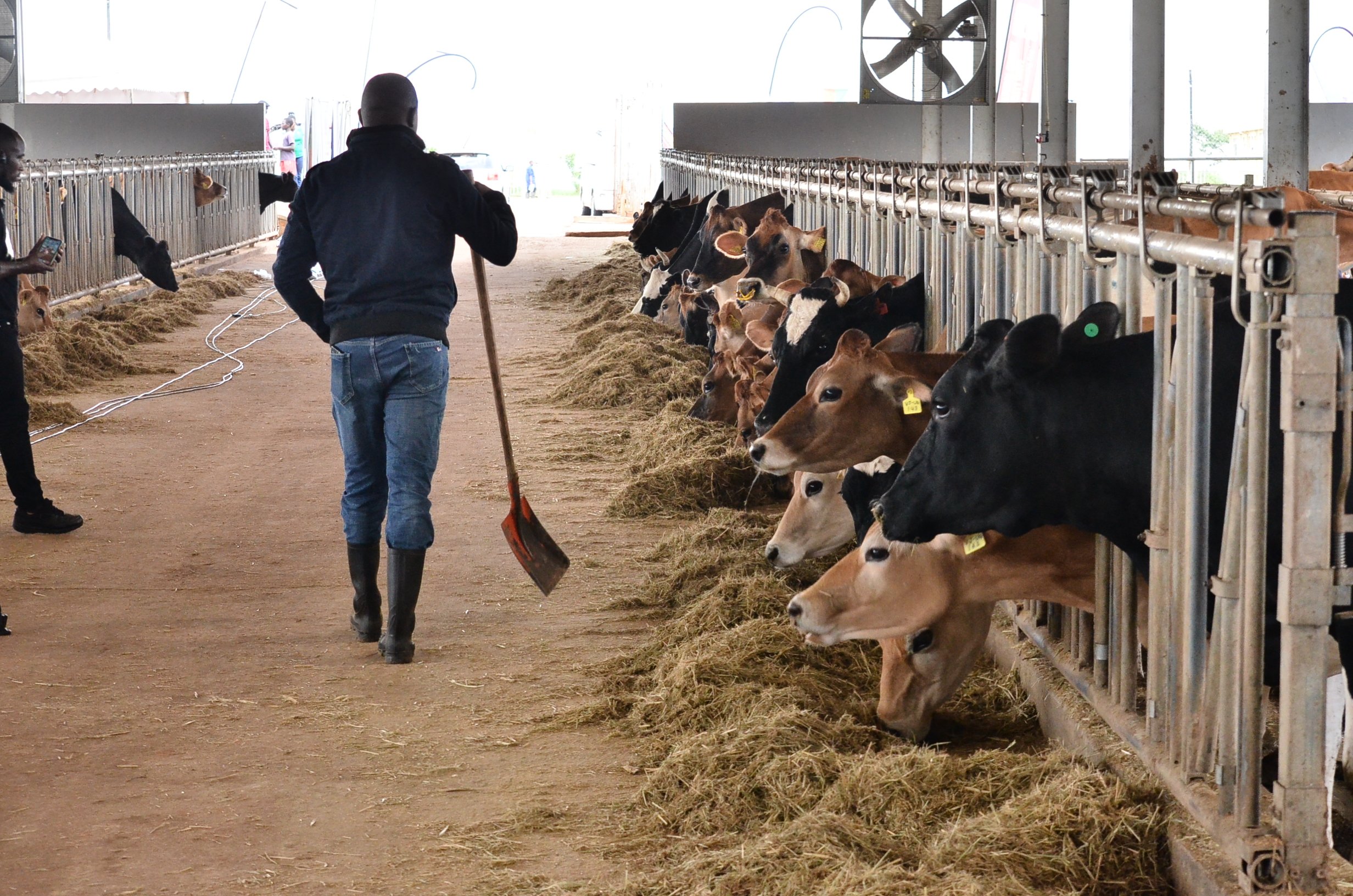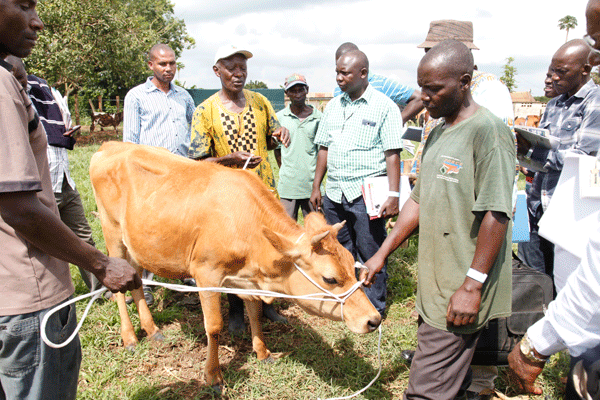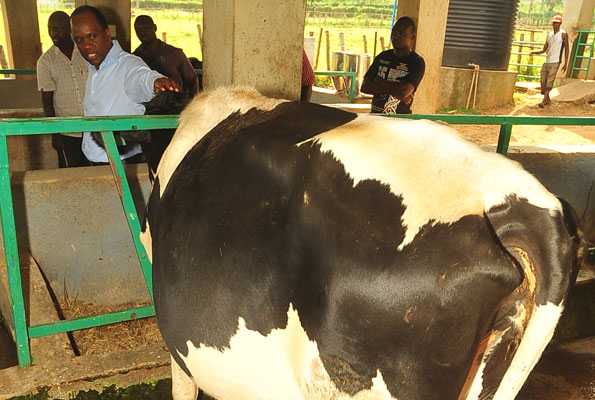Prime
An expert’s view on how to start making profits on your dairy farm

Viking jesrey cows in the NaLIRRI cow shade in Nakyesasa. These improved cows produce milk with high butter content. Photo/George Katongole
What you need to know:
- Most of the dairy farmers in Uganda are thought to be making losses mainly because of poor management systems and the perception of treating dairy farming as a mere side hustle.
- Significant milk losses occur right from the farm level amounting to 8.4 million litres per year in Uganda.
Dairy farmers in Uganda continue to count losses with many facing frustrations. Others merely treat their farms as a hobby because of the high cost of inputs including feeding, veterinary services, spoilage and poor market prices, among others.
Post-harvest losses of milk at the farm represent 1.3 to 6.4 percent of the value of available milk at the farm level. Losses are also high; in 2007, losses accounted for about 10 percent of total production implying a value of more than $23m (about Shs85b).
Along the marketing chain, milk loss is mainly due to spillage and spoilage. These losses are occasioned by poor access to markets, poor milk handling practices as well as irregular power supply in milk areas where dairy cows are reared. Most of the milk collection centres in the cattle corridor of Uganda are off the main power grid.
The burden of most of the post-harvest milk losses are experienced among the small-scale informal dairy sector. This is a critical area because according to a FAO report of 2004, Ugandan milk production is largely dominated by small-scale farmers who own more than 90 percent of the national cattle population.
Profitability looks at fixing as many leaks as possible while treating dairy operations as a business with a proper plan and objectives.
Profitability of dairy farms depends on multiple factors but at the heart of this is the change in attitude by the small scale farmers. With elevated expenses, farmers need to position their farms as a business.
“For dairy business owners having a thoughtful awareness of dairy industry trends, production benchmarks, and business aspects remain ever so vital,” Marnix Weeda, a Dutch dairy farming expert, says.
Improved genetics
The national livestock census report of 2008 shows that Uganda is still over reliant on the indigenous cattle breeds contributing 93.6 percent. The remainder is exotic or cross. Yet in 2007 these improved breeds produced around 60 percent of all milk in Uganda.
Weeda explains that by farmers buying high performing dairy cows, they are able to produce four-fold as much milk as an average dairy cow.
These herds ought to utilise modern dairy management practices, incorporate high-quality genetics in their breeding programs, ensure cows have comfortable environments, provide high-quality health care, and manage reproduction efficiently.
Genex Urus has a genetics catalogue of Ayrshire, Brown Swiss, Guernsey, Holsteins, Jersey, milking shorthorn and mixed breeds which can give farmers substantial milk supplies. A Holstein, for instance, gives as much as 25 litres a day. Farmers, therefore, need to introduce more efficient cows in their herds to harvest more milk.
Cow welfare
There are three major concepts of animal welfare: health and production; natural behaviour; and feelings. Farmers, according to experts, need to offer their cows a conducive environment.
A profitable dairy farm should ensure unlimited availability of feed and water, minimal production-related diseases as well as a clean and comfortable environment free from fear or pain.
Cows in flexible equipment experience less stress and no injuries, which leads to longer living time, better heat cycles and increased milk production.
Weeda explains that dairy cows need proper feeding. A milking cow can drink anywhere between 10-15 times a day and in that time she can drink up to 20 litres of water. A cow that does not drink enough does not give enough milk to the farmer.
It is the same as nutrition. A milking cow needs up to 25 kilogrammes of dry matter per day.
On top of that, a milking cow needs a shade to rest, the recommended is 14-15 hours a day. That is the time it is ruminating and making use of the water to make milk.
Farm management
Farm input resources which include land, labour, capital and entrepreneur form the bulk of proper dairy farm management. Proper understanding of these resources is very essential, as no production can take place without them.
Every successful dairy farmer needs to keep data to know what is going on around their farm. Farmers, for instance, need to understand the breeds of their cows, their feeding, drinking, health and expenses to be able to make money. “Unless it is a hobby, record keeping is an important element in successful dairy farming,” says Dr Hamid Lutalo, the regional director of Genex Urus, a genetics company.
Generally, proper farm management enables the farmer to understand which enterprise is giving maximum profit, determine the most productive cows, find ways of increasing efficiency on the farm, study production, assess risk and understand the performance of farm machinery.
Fertility management
Dr Lutalo says that managing fertility is an important aspect in profitable dairy farming. He says that breeding programmes now include traits aimed at increasing longevity and decreasing calving intervals which enable farmers to select desired traits in their herds.
In-vitro fertilisation (IVF) and embryo transfer are significant tools to increase genetic selection. Multiple ovulation and embryo transfer remains the most cost-effective method for all significant dairy breeds.
Dr Timothy Kasule, an embryologist at the National Livestock Resources Research Institute (NaLIRRI) in Nakyesasa urges farmers to adopt embryo transfer to speed their on-farm genetic production rate four-fold. He explains that with a careful fertilisation process, embryo transfer is the kind of breeding farmers need.
Efficient transport
Milk can go bad in about two hours when it is left at room temperature. For the small scale dairy farmers, this is a serious challenge that leads to use of inappropriate transportation of milk exposing it to contamination and thus losses. According to the Dairy Development Authority, national milk production is 2.2 billion litres per year. Of this, only 33 percent is processed. The remaining 67 percent is lost along the value chain.
Experts argue that from farm to the collection centres, farmers make substantial losses that need to be mitigated.
Along the market chain, cooling mechanisms should be at the disposal of the farmers. Stainless steel milk cans with a capacity of up to 50 litres that cost about Shs350,000 are the most immediate option.
“With the increasing climate change there is need to adopt production enhancement and quality management practices to maximise revenue in dairy,” says John Ssenyonga, the director of programmes at Heifer International, an organisation supporting small scale dairy farmers with milk cans and pulverizers through a three-year dairy value chain project codenamed Accelerate Dairy Production and Productivity (ADAP).




